This week’s main review is Transformers #1, part of the ongoing launch of Skybound’s new shared Energon Universe. Plus, the Wednesday Comics Team has its usual rundown of the new #1s, finales and other notable issues from non-Big 2 publishers, all of which you can find below … enjoy!
 Transformers #1
Transformers #1
Writer/Artist: Daniel Warren Johnson
Colorist: Mike Spicer
Letterer: Rus Wooton
Publisher: Image Comics – Skybound
Review by Billy Henehan
It’s not even Wednesday, and I’m reading Transformers #1 by Daniel Warren Johnson and Mike Spicer. I feel like a lucky man. I first saw the art for this book at HeroesCon. I asked DWJ for a signature during a low point in the show on Sunday, and told him I was psyched for his Transformers debut (then 4 months away). He looked around and then conspiratorially leaned in and asked “Do you want to see issue 1?”
Momma Henehan didn’t raise no fool; I immediately answered yes, I wanted to see the new Transformers #1. He proceeded to show me art on his phone for the first issue. It was black and white, hadn’t been colored yet, but man, it had all the kinetic energy that you’d expect from a Daniel Warren Johnson comic. And reading Transformers #1 now? In full color and fully rendered? Chef’s kiss. I haven’t been this excited about a Transformers comic since IDW continued the Marvel timeline with Transformers: Regeneration One.
The first issue of this new series is essentially Marvel’s Transformers #1 of a 4 Issue Limited Series as reinterpreted by DWJ. The Ark crashes to Earth. Teletran-1 revives Autobots and Decepticons alike, but the order difference between Marvel’s Transformers #1, the first episode of Sunbow’s Transformers, and this issue makes all the difference in the world. It’s the same, but it’s different; and DWJ threads that needle with perfection.
Daniel Warren Johnson’s artwork in Transformers #1 is as kinetic as you’d expect from reading his prior comics or seeing his convention sketches. In a slight nod to Do A Powerbomb, Optimus Prime backflips a Decepticon to the ground. If you’re a fan of G1 Transformers, you’re in good hands here. The Witwicky family is present, as are the G1 versions of your favorite Transformers. We’re 18 years removed from IDW’s Transformers #1 comic and 39 years from Marvel’s Transformers #1 comic. This new Transformers #1 from Image/Skybound may be different (part of a new shared universe with Void Rivals and G.I. Joe), but clearly the franchise is in good hands with DWJ.
Verdict: BUY
 Abbott 1979 #1
Abbott 1979 #1
Written by Saladin Ahmed
Illustrated by Sami Kivelä
Colored by Dan Jackson
Lettered by Jim Campbell
Published by BOOM! Studios
Review by Ricardo Serrano Denis
Abbott’s been through a lot. Defending the integrity of journalism while keeping the forces of darkness at bay with her powers can, understandably, take a toll. Saladin Ahmed and Sami Kivelä’s Abbott 1979 certainly wants readers to feel that in this third story arc of the critically acclaimed horror/political thriller that lives squarely in the world of Alan Pakula’s All the President’s Men and the many blaxploitation movies of the Seventies. They achieve it well in this first issues, reminding readers why Abbott is still one of the best characters in horror comics on the stands.
The story opens with an emotionally depleted Abbott attending the wake of a photographer. She’s struggling with work, lost and depressed following the events of the series’ second arc. The Umbra is still present and strong, and she’s getting tired of fighting them. Journalism is taking a backseat to television, which is made worse by the fact Ronald Reagan is about to be president and the news is treating the race like a blockbuster movie. Things aren’t looking good for anyone, and Abbott’s powers are about to start acting up.
Ahmed and Kivelä build upon Abbott’s hometown city of Detroit as an extension of the magical journalist’s emotional state. The series has always sported a dark and purple-tinged color palette, but this time around things look especially dire with darker tones. The country is changing for the worse and the growing popularity of TV signals a change in how people consume the truth.
The supernatural threat follows suit, becoming more aggressive and invasive as Abbott’s world gets more and more distorted. Ahmed and Kivelä push Abbott down to the ground early on, but they never make her look weak. The character’s strength, already well established in the previous two stories, is still the reason why you come back to the comic. You want to see how she pulls off incredible feats of magic and truth-seeking to uncover the mysteries that ail the city of Detroit. The same transfers over here, but the stakes feel more personal and more dangerous.
There’s an interesting reflection struck in Abbott 1979 involving Abbott’s strength and how it feeds off journalism’s presence in a particular point in time. If Superman’s powers come from the sun, Abbott’s comes from journalistic truth. As one wanes, the other suffers. It’s a clever way to portray how important Abbott’s work is for her and her community. It makes sure the story never loses sight of the journalism angle and the commentary it wants to produce with it.
Abbott 1979 comes at a time when the lead character is struggling with the future of truth and her role in the fight for it as new media takes over (a timely take that makes it easy to see our current social media fears in the age of television). The series continues to push for a broader discussions of truth with strong horror sensibilities behind the wheel. Comics need more characters like Abbott. The kind that feel urgent, necessary, and confrontational.
Verdict: BUY
 The Midnite Show #1
The Midnite Show #1
Writer: Cullen Bunn
Artist: Brian Hurtt
Colorist: Bill Crabtree
Letterer: Jim Campbell
Publisher: Dark Horse Comics
Review by Clyde Hall
The Midnite Show #1: Lost films, especially lost horror films, are the stuff of cinephile quests. They reflect real life discoveries and restorations of films once feared lost, such as the 1910 silent short feature Frankenstein. This Halloween season, Dark Horse Comics conjures a supernatural tale centered on Basil Saxon’s lost monster movie opus, ‘God of Monsters’.
In the story, Saxon is a combination Orson Welles and Lon Chaney, Sr. He created the legendary makeup for his screen portrayals of five classic cinema creatures in the 1950’s heyday of Midnight Studios. The culmination of that series was to be a sinister showpiece uniting all five monsters in a feature written by, directed by, and starring Saxon. That is until a studio fire terminated the incomplete production and destroyed the existing footage.
In the initial issue of The Midnite Show, surviving footage of ‘God of Monsters’ has been discovered and is set for a film festival premiere. But on the night of the event, residents of modern festival host community Cedar Bluffs begin encountering eerily familiar cinematic monsters. Horror fans and festivalgoers may be the only hope for unraveling the murderous mystery of a cursed film inflicting its infernal legacy on the unsuspecting citizenry!
Cullen Bunn’s script is a sufficient sketchbook of the title’s cast and potential protagonists. His affinity for the classic cinema monsters shines through as well, though the setup itself comes off nebulous in some respects.
What lost film hasn’t been the source of endless conjecture by fans and film detectives hoping to uncover surviving portions or stills? Yet the speculative how-and-whys of a surviving print are conspicuous in their absences here. Even suggested theories in passing (clips found among the holdings of a former studio mogul, or rushes discovered in a former cast member’s mementos) would have served better than the “Somehow, Palpatine returned,” catch-all offered.
If readers can overlook this element, there are several strengths which recommend the title. The modern cast is an interesting mix ranging from online influencers to theater workers to venerable horror hosts to former Scream Queens. The issue’s narrative alternates deftly between the classic Hollywood staging, the celluloid movie scenes themselves, and the everyday happenings in modern Cedar Bluffs as they’re suddenly interrupted by film monsters from half a century ago.
The art of Brian Hurtt ably couples classic cinema horror reality with a modern setting. It channels a vibrant The Monster Squad sensibility when the creature invasion begins. Readers who enjoy such a blending will find much satisfaction in Hurtt’s aesthetics for this portion of the tale.
As the first installment of a 4-issue miniseries, The Midnite Show #1 is a worthy Halloween treat. For some, it may be more peanut butter kisses than fun-size Snickers depending on how nostalgic they’re feeling. But if classic Universal horror films and 1950s monster movie marathons are your spooky season delights, the concession stand is open.
Verdict: BUY
Wednesday Comics Reviews
Alice Cooper #1 (Dynamite Comics): Alice Cooper returns to publication in a new story where he is set to face off against Lucifer. Lucifer’s ambitions to be a great musician, to be loved by fans, finds competition in other artists. Lucifer does what any bad sport would do and gets rid of his competitors to ensure that his audience can gravitate to him easier. The one artist in his lane that he can’t seem to get is Alice Cooper, real-life musical artist and in-comics supernatural figure and Nightmare Lord. Narratively there’s a nice bounce between characters and how the story moves from moment to moment, as writer Rodney Barnes lets new and old readers alike learn Lucifer and Alice Cooper as people. The art of Edu Menna works to ground the story from easily recognizable renditions of real musicians to the heavy blacks that really create a sense of unease and a sense of the macabre. The colors of Adriano Lucas pair well with the rendering of the characters, playing with bright and saturated colors that keep the eye moving through the page. The letters of Troy Peteri bring the whole thing together, playing with colored narration boxes to distinguish the characters that speak on the page, giving them distinct voices. Fans of Alice Cooper will likely get the biggest kick out of this but it’s accessible outside of that and I think that really works as a strength of the story. —Khalid Johnson
The Devil That Wears My Face (Mad Cave Studio): The genre of supernatural horror as it interacts with aspects of real-life faith and religious organizations has always been popular. Almost always, stories in this genre seek to say something about the organizations they feature, with The Devil that Wears my Face as no exception. David Pepose and Alex Cormack work together to create a world showcasing the split focusses of the church during a time of change. The horrors, both supernatural and earthly, of those who look to the church for salvation and assistance, as well as those in positions of power hoping only to further their own agendas. As one of the more difficult genres to capture in comics for its often many audio-related cues, Pepose maintains the building dread and suspense readers will have over dear Father Vieri. Cormack’s art and colors contribute to the horror atmosphere of Pepose’s script, likening it something you may expect to encounter on TV late night in the fall season. With letters from Justin Birch, you hear the voice of the demon as it makes its kills and the greed in the voices of the cardinals of the Vatican. Despite the church keeping many themselves, it’s no secret this book is setting itself up to be a horror comic worth following. —Bryan Reheil
Ranger Academy #1 (BOOM! Studios): With chroma-coded mantras like “know the way, show the way,” and a wild girl shepherd of a red ranger, Ranger Academy kicks off the school year with enough worldbuilding and characterization to enroll just about anyone. Especially so for the sci-fi/fantasy prose fans out there that love the large cast, big world, bigger mystery, and wry, witty banter that adapt well into comics. For those not in that venn diagram, Ranger Academy #1 feels like a romp through a second season of an anime your friends watch or an actual play ttrpg you’re woefully behind on (in a good way)! Behind the dialogue, writer Maria Ingrande Mora instills enough personality in forward-moving dialogue without the burden of over-expositing the jump-in point. Behind the layouts, illustrator Jo Mi-Gyeong keeps panels in stacks– widescreen and atop one another, or portrait and in a row, staccato-like– this rhythm helps keep the moments easy to consume and visually diverse without requiring elaborate layouts to pop the page; sometimes, as in the case of a rope/cliff sequence, Mi-Gyeong can build a confusing sequence of events, but the real star is in character acting and expressions. Behind the palette, colorist Fabiana Mascolo keeps Sage’s life drab, but saturated, glum, but bright, and then when we get to the actual Ranger Academy, opulent warm tones and chroma-coded color keys paint the mood, which excites future outings. Behind the balloons, letterers Cardinal Rae and Ed Dukeshire keep it simple with rounded-corner inner narration, but fly too high with balloons that tip their white interior over the panel border, which seems unnecessary with such effective layouts. If none of this was enough to sell you on Ranger Academy, uhhh… there’s a pink ranger coded enby himbo that will have their own tumblr tag when issue #1 lands, so better enroll today, cadet! Whatcha waitin’ for! —Beau Q.
Star Trek: Holo-Ween #1 (IDW Publishing): Move over, “Catspaw”: there’s a new Halloween-themed Star Trek story in town: Star Trek: Holo-Ween #1 by Chris Sequeira, Joe Eisma, Charlie Kirchoff, and Clayton Cowles. First off, shout-out to editorial for allowing this to be a multi-issue arc, so the story can have some space to breath. Like Star Trek: Deep Space Nine: Dog of War, this story plays out like a lost episode of Star Trek: The Next Generation. It’s also a sequel to the Star Trek: The Original Series episode “Wolf in the Fold,” one that integrates the Enterprise-D’s holodeck. Whether or not this story will ultimately succeed remains to be seen, but as an opening chapter, this issue works well enough. With an interesting style and some very well designated dialogue boxes, Holo-Ween #1 is fun, but probably best suited to die-hard fans of the core TNG crew. I’m hoping after all the holographic chaos is suppressed, we get to see the D team enjoy that Halloween party they were planning. —Avery Kaplan
The Prog Report
2000 AD Prog 2352 (Rebellion Publishing): We’re starting a new feature this week, looking at one of my favorite things in comics, 2000 AD’s Prog (which you can check out here, online, DRM free, with 30-plus pages of comics for $1.99…an absurdly good value). This week’s magazine is a set of very strong comics (if last week you missed the start of Judge Dredd: Poison by Rob Williams, PJ Holden, Peter Doherty, and Simon Bowland, you ought to catch up on that, it’s very good, and part II looks fantastic), but an especially great new story here is The Devil’s Railroad: Part One by Peter Milligan, Rufus Dayglo, Jose Villarrubia, and Jim Campbell. Dayglo’s work (colored to perfection by Villarrubia) is bonkers and intricate and kinetic, and just about perfect for Milligan’s scripting. The creators team for a story focused on a young couple from a war-torn world, who learn they’ve conceived their first child and so they are risking everything they have to journey toward a (supposedly) safer life on Earth. Like the best Prog stories, The Devil’s Railroad takes an issue of our day — migrant crises — and reflects it through a dystopian lens that makes clear this ravaged sci-fi world is not so different from our own. Plus, it ends with a wild twist and memorable surprise imagery. Excited to follow this one next week, which I will do, as part of the second installment of this new feature! —Zack Quaintance
Read more entries in the Wednesday Comics reviews series!


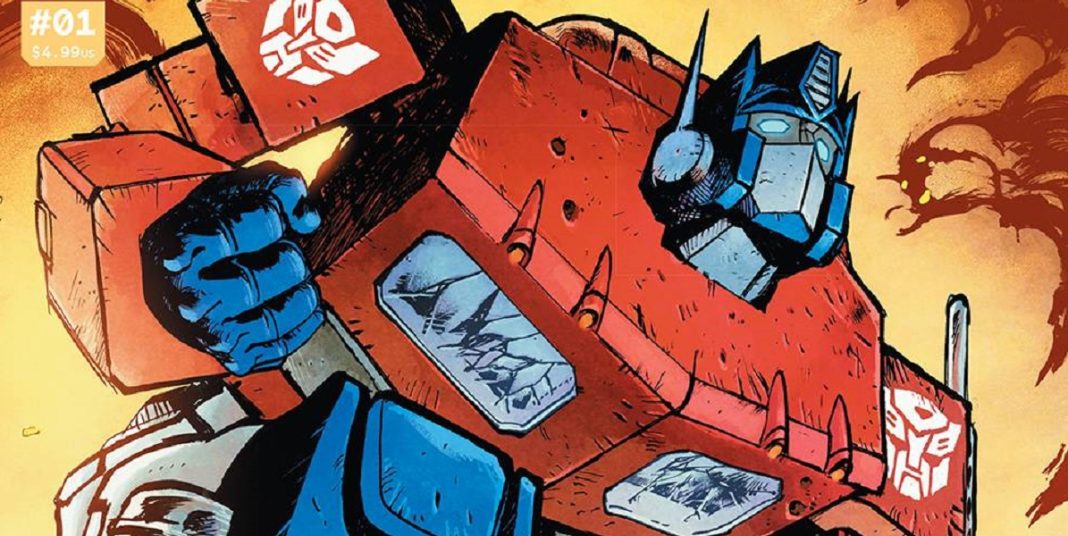
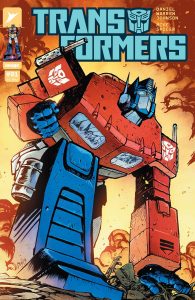
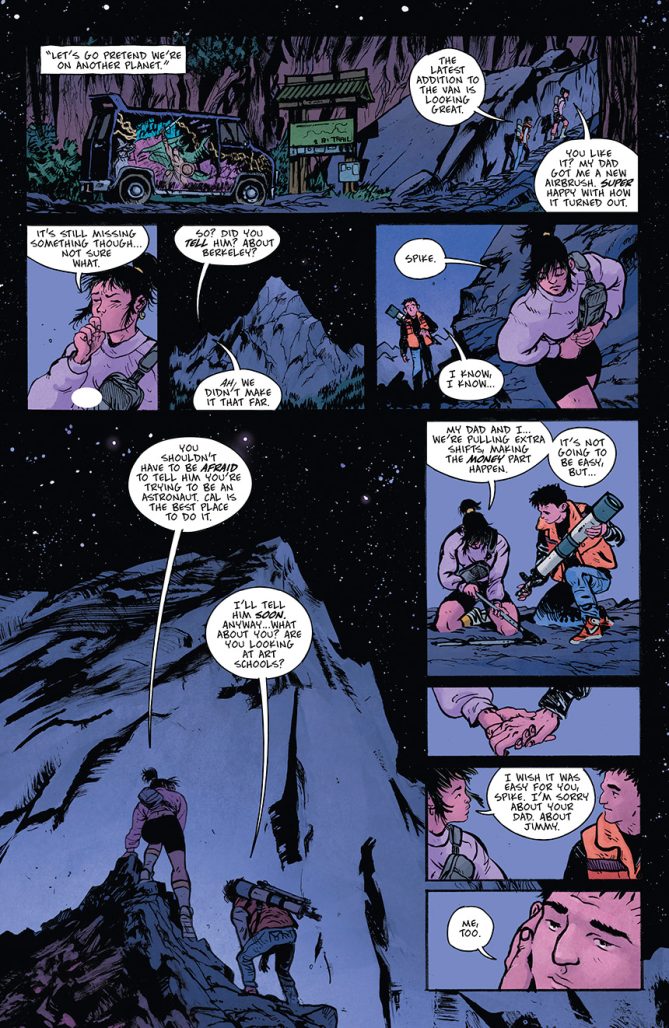
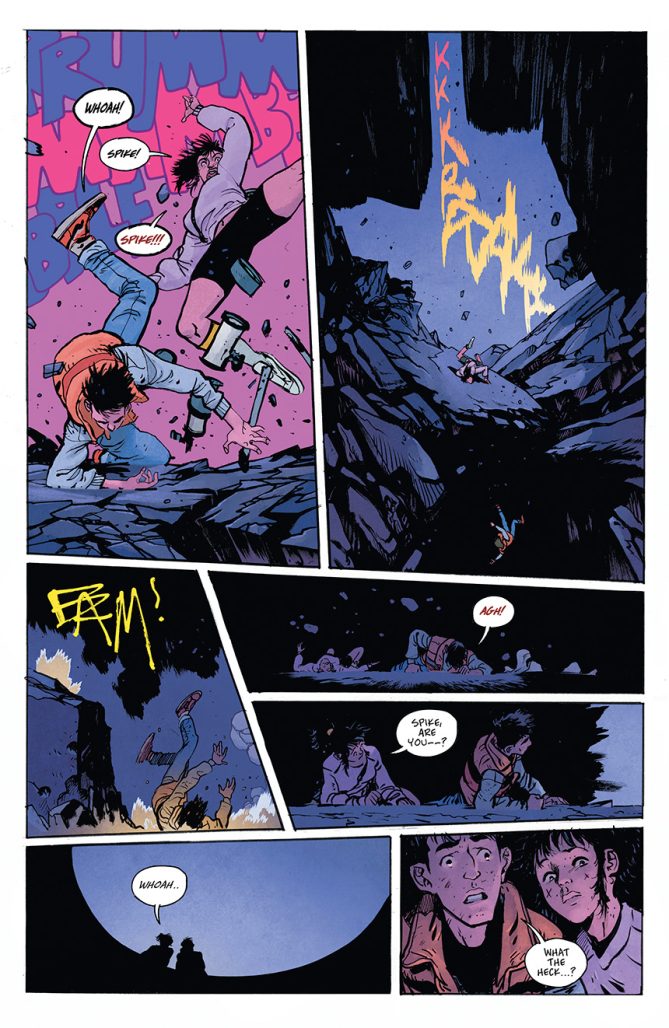
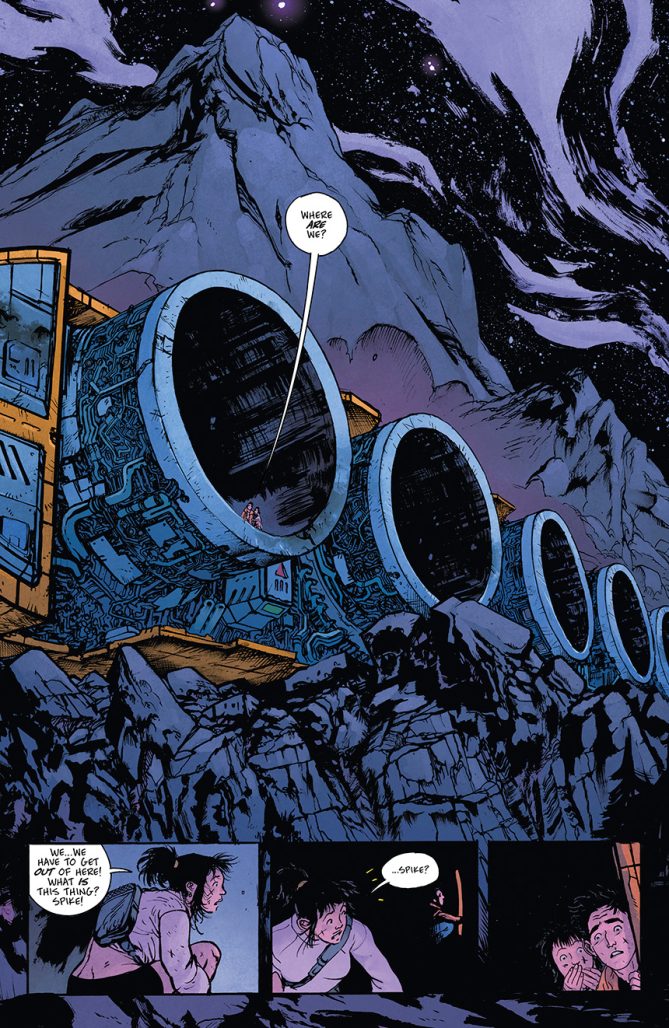
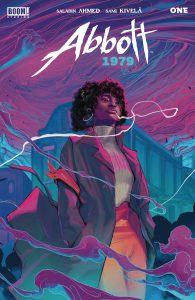
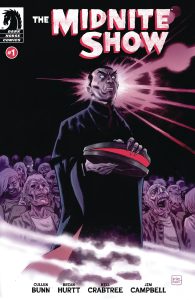
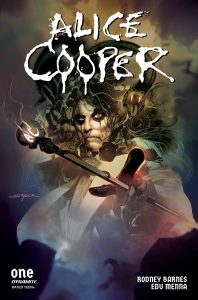
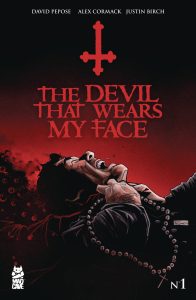
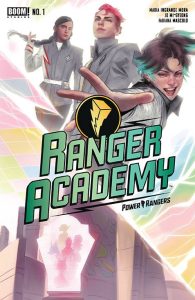
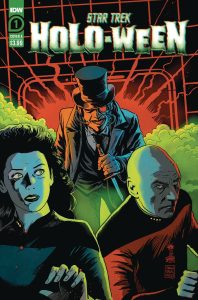 Star Trek: Holo-Ween #1 (IDW Publishing): Move over, “Catspaw”: there’s a new Halloween-themed Star Trek story in town: Star Trek: Holo-Ween #1 by Chris Sequeira, Joe Eisma, Charlie Kirchoff, and Clayton Cowles. First off, shout-out to editorial for allowing this to be a multi-issue arc, so the story can have some space to breath. Like Star Trek: Deep Space Nine: Dog of War, this story plays out like a lost episode of Star Trek: The Next Generation. It’s also a sequel to the Star Trek: The Original Series episode “Wolf in the Fold,” one that integrates the Enterprise-D’s holodeck. Whether or not this story will ultimately succeed remains to be seen, but as an opening chapter, this issue works well enough. With an interesting style and some very well designated dialogue boxes, Holo-Ween #1 is fun, but probably best suited to die-hard fans of the core TNG crew. I’m hoping after all the holographic chaos is suppressed, we get to see the D team enjoy that Halloween party they were planning. —
Star Trek: Holo-Ween #1 (IDW Publishing): Move over, “Catspaw”: there’s a new Halloween-themed Star Trek story in town: Star Trek: Holo-Ween #1 by Chris Sequeira, Joe Eisma, Charlie Kirchoff, and Clayton Cowles. First off, shout-out to editorial for allowing this to be a multi-issue arc, so the story can have some space to breath. Like Star Trek: Deep Space Nine: Dog of War, this story plays out like a lost episode of Star Trek: The Next Generation. It’s also a sequel to the Star Trek: The Original Series episode “Wolf in the Fold,” one that integrates the Enterprise-D’s holodeck. Whether or not this story will ultimately succeed remains to be seen, but as an opening chapter, this issue works well enough. With an interesting style and some very well designated dialogue boxes, Holo-Ween #1 is fun, but probably best suited to die-hard fans of the core TNG crew. I’m hoping after all the holographic chaos is suppressed, we get to see the D team enjoy that Halloween party they were planning. —




